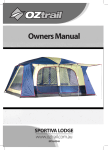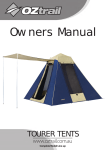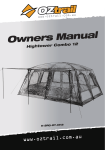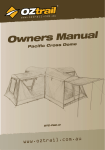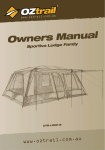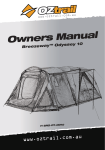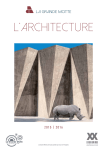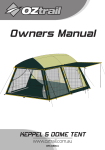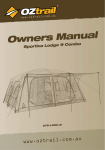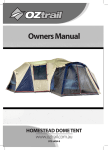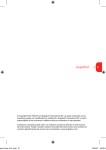Download Owners Manual
Transcript
l a u n a M s r e n Ow ™ Beach Dome p U p o P s u c is Hib MPB-BDH-B au www.oztrail.com. Contents Assembly Instructions .............................. 4 130cm 110cm 115cm Products and Parts .................................... 3 235cm 2.3kg Disassembly Instructions and Folding Instructions ......................... 5 FEATURES Warranty ...................................................... 7 • Wide panoramic front opening Prolonging The Life Of Your Tent/Shelter ............................................. 8 • Maximum sun protection with UPF50+ fabric • Longer lasting UVtex Sun Tough fly fabric with silver coating • Convenient heavy-duty sewn in PE floor • Sand pegs and sand pockets are included • Packs flat into a compact circular carry bag • 1 year manufacturer’s warranty Important Safety and Care Information..................................... 9 Understanding Waterproofness........... 10 Zips............................................................ 11 HELPFUL HINT OZtrail advises you to read this owner’s manual fully and to set up and fold away your beach dome before first use to ensure all parts are present and to become familiar with the operation of your beach dome. Hibiscus Pop Up™ Beach Dome Shelter in seconds 2 For a demonstration video see www.oztrail.com.au Product Code: MPB-BDH-B Thank you for purchasing a quality OZtrail product. Please keep this Owner’s Manual in a safe and dry place, it contains information and helpful information. The following parts are included for Product Code: MPB-BDH-B Part Description 3 6 x Pegs PLEASE NOTE Due to our policy of continual product development, specifications, parts and features of the product may vary from details within this Owners Manual. HELPFUL HINT We recommend that you set up this product before you leave for your trip. Check that all parts are present and that you familiarise yourself with the assembly and disassembly of the product. If you have any questions, your OZtrail dealer will be happy to help you. 2 x Guy Ropes 1 x Tent Bag 1 x Peg Bag 4 x Sand Pockets Hibiscu s Pop Up Assembly Instructions Do not force the sprung frame, follow instructions carefully Hibiscus Pop Up Hibiscus Pop Up Step 1 Choosing the Site Select a sheltered site protected from the wind that will not allow water to pond under the beach dome floor. Clear a level area of all stones, twigs, etc. Peg Point Figure 1 Step 2 Standing the beach dome up Remove the beach dome from the carry bag and carefully release elastic strap, gently allow the beach dome to unfold and open fully. Step 3 Peg down the beach dome Position the beach dome facing the desired direction. Peg out the corners first. For peg point locations, see Figure 1. Anchor the beach dome to the ground by inserting the pegs through the loops around the base of the beach dome at an angle of 45 degrees, see figure 2. Firm but not tight. As you work from one peg point to the other around the beach dome base pull the floor firmly, but not tight. Ensure all guy ropes are utilised. Make a loop (about 30 – 50cm long) with a slider on the end of the rope and peg out as far as possible from the beach dome. Ensure all guy ropes are attached firmly and remain firm, see figure 3. For additional stability fill the sand pockets. PLEASE NOTE In severe conditions the beach dome should be dismantled 4 45 Figure 2 Figure 3 o Disassembly Instructions While the unit is standing up. Step 1 Remove pegs with a claw hammer or peg puller. Do not remove pegs from the ground by pulling on the beach dome base as this may cause damage to the beach dome. Step 9 Neatly pack down all pole loops, as indicated in Diagram 7. Step 10 Step 2 Once all pole loops are packed flat, slip the attached elastic strap over the pole loops to hold in place, as indicated in Diagram 8. Position yourself along the side of the beach dome, as indicated in Diagram 1. Step 11 Step 3 With your right hand collect and hold the centre of the two roof pole loops, as indicated in Diagram 2. Step 4 While holding the two roof poles with your right hand collect and hold the centre of the two floor pole loops in your hands, as indicated in Diagram 3. Place the beach dome into the carry bag. WARNING: At no stage is it necessary to apply any excessive force to achieve any of the above steps. The frame is sprung loaded and if the correct action is applied the beach dome will pack up with little or no force required. Excessive force will result in damage to the frame and this is not covered by warranty. Step 5 Holding all poles loops together in your left hand, now bring your left hand down towards your left knee, the beach dome will change from horizontal to vertical as you do this step, as indicated in Diagram 4. Step 6 Place your right hand on top of where the roof and floor poles are joined, as indicated in Diagram 4. Step 7 Holding the junction of the roof and floor pole loops, bring your right hand down towards your ankles, as indicated in Diagram 5. Step 8 As you finalise step 7 carefully release two of the four pole loops in your left hand so the released two pole loops go under the two pole loops still in your left hand, as indicated in Diagram 6. 5 IMPORTANT: Do not store your beach dome when damp or dirty. If you have no option but to pack away a damp or dirty beach dome, as soon as possible lay it out to air in a cool, dry and shaded area to dry and clean. Only pack it away for storage when completely dry. Disassembly Instructions 6 Warranty OZtrail warrants this product against defects for a period of one year from the date of purchase. OZtrail will repair or replace the product, at its discretion, should a warrantable defect arise within the warranty period. If the exact model is unavailable a model of equivalent nature will be substituted at our discretion. This warranty excludes faults and failures caused by improper use and abuse; fair wear and tear; or failure to follow instructions regarding care and maintenance. A warranty may be claimed by returning the product to its place of purchase, with a detailed proof-ofpurchase clearly showing the date and detail of the purchase. You may also contact OZtrail Leisure Products, by phone: 07 3279 1800, or in writing: PO Box 1, Sumner Park DC, 4074, QLD, by email: [email protected]. The benefits under OZtrail’s warranty against defects are in addition to other rights and remedies under law in relation to goods. Our goods come with guarantees that cannot be excluded under the Australian Consumer Law. You are entitled to a replacement or refund for a major failure and for compensation for any other reasonably foreseeable loss or damage. You are also entitled to have the goods repaired or replaced if the goods fail to be of acceptable quality and the failure does not amount to a major failure. For more detailed information and an explanation of these terms see www.oztrail. com.au/warranty PLEASE NOTE Accessories shown may be for display purposes only and not included with the product. Due to our policy of continual product development, specifications and features of this product may vary from what is stated. 7 HELPFUL HINT: AVOIDING MOULD AND MILDEW You should always pack your products both clean and completely dry. In many climates there is a risk of Mould or Mildew damage to materials that are not packed away in a dry state, this condition is not covered by the warranty. After each camping trip, clean you products with warm soapy water and allow them to dry completely after rinsing them with fresh water. CARING FOR YOUR SHOCK CORD Shock cord is designed to help you keep your tent poles organised and to allow quick assembly of the poles. Over stretching the cord or dropping the poles will cause shock cord failure and this condition is not covered by the warranty. INSURANCE, YOUR PROTECTION AGAINST THE UNEXPECTED Most people have product problems from unexpected sources. Extreme weather is a good example of an unexpected problem. Make sure that you place you expensive Camping Products on your Home and Contents Insurance policy. Most good Insurers will cover the Storm damage to your tent or other products that falls outside of the warranty. Prolonging The Life Of Your Tent/Shelter • Temporary use only. Although our fabrics are treated for extra UV resistance, continuous exposure to sun light will reduce the life of the fabric. Fading of colour is an early warning sign. OZtrail products are not designed as permanent dwellings or structures. • During rain always lower awnings to avoid water ponding. • Never store a wet and/or soiled tent/shelter; as mildew and corrosion can form. Always allow the tent to dry completely before packing and stowing. If mildew occurs, use a soft bristle brush or sponge with mild detergent to clean it off. After beach use or wet weather treat all zips, poles and pegs with silicon spray. • The elastic shock cord within the poles is provided for easy assembly of the poles. The shock cord is not required for any structural reason. The poles and tent perform perfectly well without the shock cord. Age, over stretching and mishandling may cause failure. Shock cord is not covered by warranty. It’s easy to replace, see the instructions on page 12. • Sometimes the zipper coil bursts open or does not close. This could be due to wear or metal fatigue. The problem can be easily fixed, see the instructions on page 15. • Always carry a roll of heavy duty tape for simple repairs to small rips, cuts and ash burns. This not only blocks the hole, it will 8 prevent further tearing. Heavy Duty tape is also helpful for emergency pole repairs and many other uses around the camp site. • When removing pegs, do not use the webbing or corner of the tent as your handle. Either use another peg, a peg remover or the claw of a hammer hooked under the peg to remove them. HELPFUL HINT CONDITIONING YOUR NEW TENT Once you get your new tent home, it is important to condition the tent. Simply pitch your tent and wet it down with your garden hose until the fabric and all seams are saturated. Pay particular attention to the seams - the thread swells when wet and blocks the needle holes. The needle holes also shrink around the thread. The fabric also benefits from this because the fibre swells into the weave and the waterproof treatment settles within the fabric. Let the tent dry completely before repeating this wetting and drying process until there is no leakage during hosing. Always pack your tent away dry. Important Safety and Care Information Please read before setting up your tent/shelter CAMP SAFE - SAFETY HABITS Fabrics used in the construction of OZtrail tents/ shelter are treated for fire retardant properties. This treatment reduces the rate at which the fabric will burn. The fire retardant fabric will still burn if it comes into direct contact with a flame or extreme heat. The application of any foreign substance to the fabric such as some water proofing treatments or insect sprays may render the fire retardant treatment process ineffective. TO PREVENT INJURY CAUSED BY ELECTRICITY • Always exercise care when using electricity and electric lighting in and near tents/shelters. Only use 12 volt lighting. The following pages cover several safety tips that will help you avoid some of the common hazards encountered on a camping trip. TO PREVENT INJURY CAUSED BY GAS POISONING OR SUFFOCATION • Gas, fumes or lack of oxygen within the tent/shelter could result in unconsciousness, brain damage and even death. • Always ensure your tent/shelter is well ventilated. Even on the coldest night do not close every vent, window and door. A well ventilated tent not only maintains healthy Oxygen levels but also reduces condensation build up inside the tent. • • Do not use fuel burning, oxygen consuming devices inside the tent. This includes candles, gas lanterns, kerosene lamps, stoves, cooking and heating appliances. To prevent injury caused by your camping environment 5 4 3 2 1 • Do not pitch your tent/ shelter on an area that could get flooded • Do not pitch your tent/ shelter near cliffs in case of collapse or rock fall • Do not leave your tent/ shelter erected in strong winds - collapse the tent onto the ground and seek refuge in your vehicle • Do not pitch your tent/ shelter under trees with dead branches or under trees known to drop branches Do not use gas appliances of any kind inside the tent/shelter. TO PREVENT INJURY CAUSED BY FIRE 9 • Do not pitch the tent/shelter near a camp fire or any other flame source • Do not use candles, matches or any other flame source in or near the tent (this includes stoves, cooking equipment, lighting and heating appliances) • Only use recommended water repellent compounds on the tent/shelter fly • Do not spray tent fabrics with insecticides Understanding Waterproofness OZtrail tents are manufactured from waterproof and water repellent fabrics. However, with the addition of seams, zips and other desirable features a recreational tent will not be as waterproof as a car, house or other solid structures. The following are common examples of how water can enter a tent: - CONDENSATION When warm moist air meets cooler air, condensation occurs. The tent/shelter fly forms an impermeable layer between the inside and outside conditions. The moisture inside the tent/ shelter condenses on the fabric. Sometimes in cold conditions it appears that the fabric is leaking when in fact the cause is condensation. Condensation can be reduced if the tent/shelter is well ventilated. ZIPS All care is taken in the design to cover zips. At times wind driven rain could force water under the flaps and through the zips. To minimise this, make sure all doors and windows are closed with the flaps covering the zips. FLOOR If the ground is very wet or water pools under the floor, downward pressure of standing or kneeling on the floor could force water through the floor fabric. To prevent this, do not pitch the tent over hollows and make sure water drains away from the tent. 10 STRUCTURAL INTEGRITY A well pitched tent on level ground is structurally strong and most waterproof. During prolonged periods of rain and wind it may be necessary to tighten guy lines and reset the tent pegs and attend to drainage around the tent. Sagging and incorrect pitching weakens the tent structure and could allow water to pool on the fly placing undue forces on the tent causing leaking and breakages. Zips REDUCING THE RISK OF JAMMING FABRIC IN THE ZIP • When using the zip, hold the pull-tab between your thumb and forefinger with your thumb facing you. • As you are closing the zip clear the way in front and under the zip slider using the back of your hand, and cup the zip slider underneath with your remaining 3 fingers. Use this action for opening or closing. Keep the fabric clear of the zip slider - zip and unzip slowly. CRIMPING A ZIP-SLIDER The most common reason why zips burst open is that the zip slider does not close the coil tightly enough. Wear and tear may cause the gap marked A to open up. See Figure 4. By simply ‘crimping” the slider together at points B & C with a pair of pliers, this solves the problem most of the time. Crimping in other planes is worth a try if B & C does not work. This is to be done when the zip slider is still attached to the zip in the open position. See Figure 4. WHAT TO DO IF THE ZIPPER GETS CAUGHT • Pull the fabric bit by bit out of the slider. Do not try and pull all the fabric in one go. Do not force the slider or the fabric. IF THE SLIDER DOES NOT CLOSE THE ZIPPER PROPERLY • With use, the jaws of the zip slider can open ever so slightly. When this occurs the slider does not compress the zip teeth or coil together tightly enough and the zip bursts open or does not close. • Undo the zip and with the slider at the end of the zip lightly crimp the jaws of the slider together. Try top to bottom axis first and then side to side axis. 11 B A C Figure 4 St Un the Pla atta the fly rem St Peg a lo on pos are and For other OZtrail products to choose from, see our website or facebook.com/OZtrailAustralia. Designed & Imported by: OZtrail Leisure Products • 45 Limestone Street Darra QLD 4076 • Made in China












